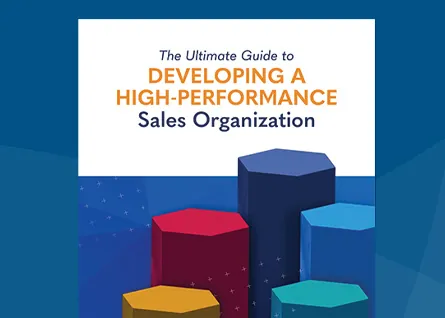A Scientific Method to Evaluating Sales Performance

Brace yourself. It’s the last week of the month and the last week of the quarter. For those sales teams ahead of their sales target, it’s going to be an enjoyable July 4. For those sales teams close to or behind their sales targets, it’s going to be a stressful end-of-quarter. As we hit the midway point of 2022, it’s time to evaluate what got us to this point. The past may be buried, but if we don’t understand the past, we are doomed to repeat it. In this article, we’ll explore how sales leaders can improve their sales team’s second-half performance by taking a scientific approach to evaluating their sales team’s first-half outcomes.
Complacency is the Enemy of High Performance
It is hard to think of anything worse than going to work every day and not achieving the sales results you desire. I would call that the definition of complacency, being content without making progress. Even if your sales team is ahead of your sales quota, the danger of becoming complacent is real. Sales teams that achieved early sales success this year could plateau and eventually struggle if they are fooled by their early sales success.
It’s natural to think your initial sales success will repeat itself quarter after quarter. But remember, there’s nothing less relevant to the market than where you were six months ago. Complacency, poor performance, and replaceability are synonyms in sales. Sales leaders who tolerate complacent sales reps are eventually replaced. A complacent sales leader should be every CEO’s biggest concern because clients are poorly served by complacent sales teams, and poorly served clients search for replacements.
Nick Saban, the legendary college football coach, called the positive press articles, accolades, and adulation about his football team “rat poison.” Saban was making the point that when his players start believing the press about themselves, they stop focusing on what made them successful. Once they lose focus, they lose football games. In sales, success can be rat poison for sales teams. When you hear, “great job, your team is awesome,” success tends to change your mindset.
It’s been said the secret to sales is to ask your prospects quality questions. Sales leaders would be wise to heed the same advice. Useful questions sales leaders can ask themselves at the end of each quarter include:
- What do we attribute our sales outcome to?
- How confident are we that current outcomes will repeat next quarter?
- Are tactics that were originally successful now falling short?
- What are the indicators we are going in the right direction?
- What are the indicators we are going in the wrong direction?
When sales leaders deliberate on these questions, new questions are generated. The purpose of this dialogue is to determine when change, adoption, or modification is appropriate. Without questioning current outcomes, complacency will result. The best way to prevent complacency is to question results. When sales leaders question their performance, they gain a deeper comprehension. Without comprehension, sales performance will always be inconsistent.
Comprehension Supersedes Consistency
For sales leaders who desire high performance, comprehension supersedes consistency. This means sales leaders should comprehend why their sales team performs at a certain level before they worry about consistency. There are many sales teams that are consistently inconsistent. Why? Simply, the sales leader does not fully comprehend how the sales team is executing the sales process. The obvious sign a sales leader lacks comprehension is a sales team that delivers above-average results one month, followed by below-average results the next.
Sales leaders who sympathize with (instead of questioning) underperforming teams inadvertently perpetuate inconsistent outcomes. When a sales team is not meeting their numbers, one of the first things to review is the conversations between the sales reps and the prospects. Understanding how receptive prospects are to the sales message is critical to understanding sales performance. Listening to real prospects in actual sales conversations with sales reps provides the best insights into what is going on with the sales team.
Today, there is off-the-shelf technology available to help sales leaders with this task. Many sales organizations use call recording with conversational intelligence built in. Conversational Intelligence is different from traditional call recording. It uses Natural Language Processing (NLP) and these platforms analyze conversations to identify topics discussed, talk patterns, questions asked, customer objections, and overall sentiment. This technology allows a deeper comprehension of how the sales team is interacting with prospects. Modern sales leadership is about leveraging technology to make faster decisions while being more proactive. The proactive sales leader influences sales outcomes, the reactive sales leader responds to sales outcomes.
Sales Leaders Must Detach Emotionally From Sales Outcomes
When sales leaders are emotionally attached to sales outcomes, they take their sales team’s results personally. If sales are strong and revenue is growing, this can inflate one’s ego and create a false sense of security. On the other hand, when sales are slow and revenue is not growing, it can negatively impact how sales leaders feel about themselves, their team, or their company. Emotions cloud decision and cloudy decisions produce less than optimal results.
For sales leaders to optimize their team’s performance, emotional detachment from sales outcomes is a requirement. This is not to say that sales leaders should be emotionally detached from their team, their prospects, or their customers. Empathy is a key characteristic of leadership. But by detaching emotionally from sales outcomes, the sales leader is better able to assess the situation, apply knowledge, and utilize experience to achieve an improved outcome. Said another way, it’s really hard for a sales leader to improve their team’s sales performance if they are judging their team.
Judgment leads to blaming and blaming makes sales performance personal. However, when the sales leader evaluates the sales outcomes, they can reach a conclusion based on quantified and qualitative data. Emotional detachment helps sales leaders position themselves as outside observers. This can be the difference between a sales leader thinking they know the answer (judgement) and looking for the answers (observing).
Executing for the Future
At this point, we have a clear understanding of why we achieved the outcomes we achieved for the first two quarters. We’ve also taken the time to evaluate how prospects are responding to our sales message. Finally, we have detached emotionally from the outcomes. Now it’s time to determine what needs to be acted upon to attain the desired sales outcomes for the remainder of the year.
At this point, the sales leader needs to create a sales hypothesis, or an educated assumption that will improve past sales results. This is a scientific approach to selling. A good sales hypothesis could look like this:
Improving ___ by ___ will increase _____ because
For example: Improving the sales team’s prospecting efficiency by 10% will increase quarterly revenue by $250,000 because our closing rate will remain the same.
A good first step for sales leaders when creating a sales hypothesis to improve future sales performance is to implement some boundaries. First, it provides focus. Second, it defines the problem to be improved. Third, it provides the sales team with objectives that are obtainable. Without boundaries, sales teams can lose focus, and everyone can end up working harder, but on the wrong things.
High performing sales teams have clarity on their sales objectives, while underperforming sales teams have vague targets. Vague sales targets are a waste of time. They sound like this, “Improve sales 25%” or “Increase Revenue.” For a sales team, increasing sales revenue 25% can sound like an unreachable goal. But improving prospecting efficiency by 10% is an obtainable objective.
In Conclusion
Developing a high-performing sales team that consistently delivers is about managing the right sales behaviors. Managing sales behavior often means changing ineffective behavior. Without a comprehensive understanding, sales leaders are guessing what behaviors to manage. Applying a scientific approach to sales requires sales leaders to question their sales outcomes, both good and bad. When sales leaders question their sales outcomes, the answers will lead to critical information about achieving the improved outcome.
As sales leaders, we are not in the trenches with prospects every day. We can get stuck into daily management prison, with activities like sales team check-ins, coaching calls, department meetings, and sales candidate interviews to name a few. Without investing the time to evaluate quarterly performance, good sales teams can become complacent and average sales teams can underperform.

- Account Planning (11)
- Awards (50)
- Client Testimonial (37)
- Personal Branding (19)
- Podcast (11)
- Research (68)
- Sales Career Development (85)
- Sales Coaching (153)
- Sales Consulting (133)
- Sales Culture (164)
- Sales Enablement (340)
- Sales Leadership (108)
- Sales Management (242)
- Sales Negotiation (16)
- Sales Prospecting (124)
- Sales Role-Playing (18)
- Sales Training (229)
- Selling Strategies (255)
- Soft Skills (67)
- Talent Management (92)
- Trusted Advisor (27)
- Virtual Selling (41)
- Webinar (10)





























